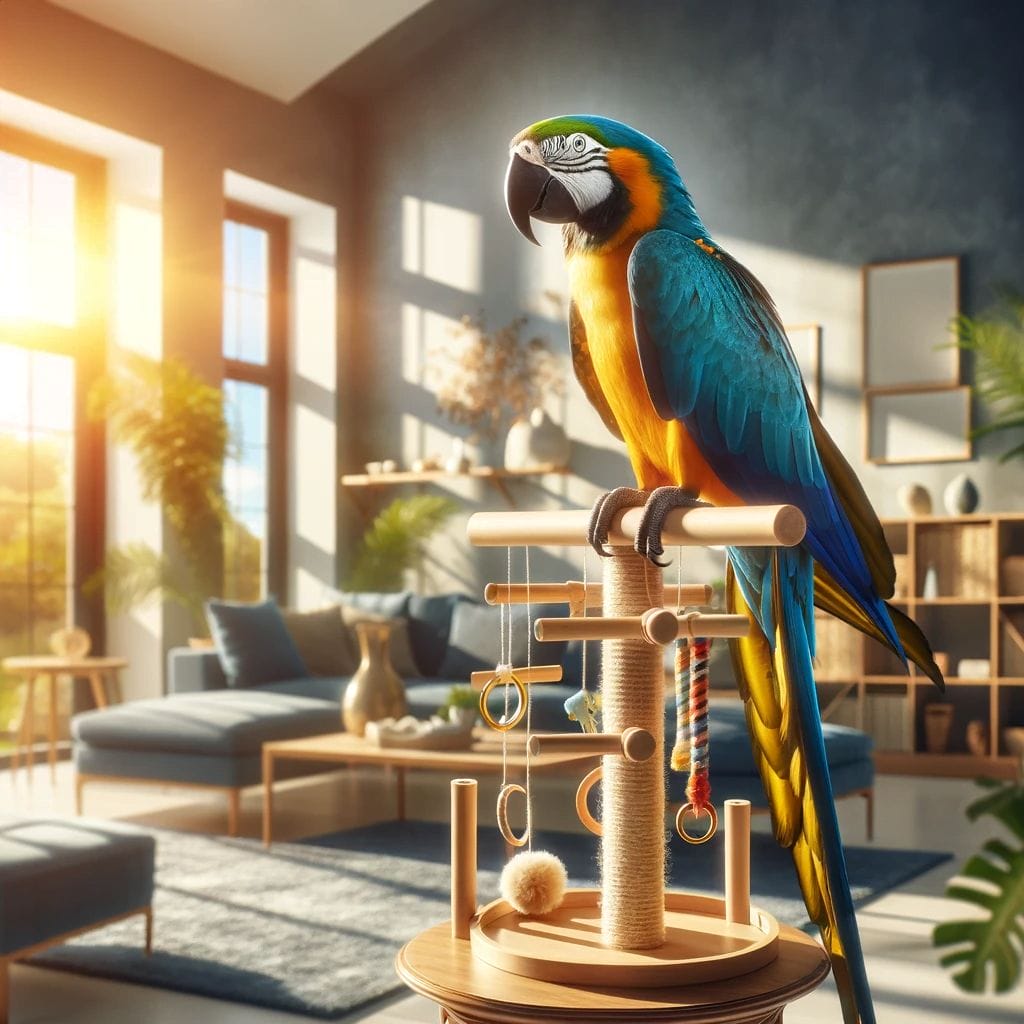Imagine your home resonating with the vibrant chatter of a scarlet macaw or the clever mimicry of an African grey. Welcoming big pet birds into your life is like opening a door to a world where feathers meet friendship and squawks blend with laughter.
You’re about to dive deep into their realm, discovering how to transform your space into their sanctuary, what fuels their flamboyant flights, and ways to nurture these intelligent beings. Along this journey, you’ll unlock secrets to bonding through training while integrating them seamlessly into family dynamics.
Your companionship will bloom as you explore unique traits of big pet birds across species – from hyacinth macaws’ cobalt blue allure to green-winged macaws’ emerald charm – all woven together by shared moments that span decades.
Table Of Contents:
- AI Illustration of Blue and Gold Macaw
- Preparing Your Home for a Big Pet Bird
- Nutritional Requirements for Big Pet Birds
- Recognizing Health Concerns in Large Parrots
- Behavioral Training & Socialization Strategies
- Integrating Large Parrots into Family Life
- Choosing Your Feathered Companion: Comparing Popular Species
- Polly Want A Cracker
 AI Illustration of Blue and Gold Macaw
AI Illustration of Blue and Gold Macaw
Preparing Your Home for a Big Pet Bird
Creating a safe and stimulating environment for large pet birds, and ensuring their physical and mental well-being is an important part of keeping big pet birds.
Selecting the Perfect Cage
Finding the right cage is like setting up a luxury condo for your feathered friend. It’s not just about size but also about style and function. A large bird needs room to spread its wings—literally. The ideal cage should let your big pet bird flap and play without hitting any bars or walls. Think of it as creating a spacious and safe environment that mimics their natural habitat. Check out your options before you pick up your big pet bird.
Cage placement and positioning are key, too. You want to give them a view without placing them in direct sunlight or drafty areas. And remember, cleanliness is next to birdliness—the importance of regular cleaning and maintenance can’t be overstated.
Enrichment Through Toys and Perches
Toys aren’t just fun—they’re essential for mental health. Imagine being stuck at home with nothing to do. That’s why providing chew toys, puzzles, and even items they can shred keeps these intelligent birds engaged—and out of trouble.
Your parrot isn’t just sitting pretty; they love learning tricks. Introduce perches at various heights so they can hop around like opera singers, hitting every note on stage.
The Essentials of Proper Lighting and Temperature
You need to know how to mimic a bird’s natural habitat with correct lighting and temperature settings.
Mimicking tropical sunrises isn’t easy, but proper lighting does wonders for their circadian rhythms while preventing behavioral issues linked with constant exposure to household lights after dark. Adjust temperature settings because nobody likes feeling chilly—or overheating during those steamy summer days.
Key Takeaway:
Find a big, stylish cage that lets your bird flap and play—think luxury condo with a view. Keep it clean and well-placed to avoid drafts or direct sun.
Toys and perches are must-haves for mental stimulation; they keep birds active like opera singers on stage. Remember, proper lighting and temperature set the mood for a happy home life.
Nutritional Requirements for Big Pet Birds
When it comes to feeding your big pet bird, think of them as the VIP guests at a five-star restaurant. Their diet should be top-notch and tailored just right. For these feathered friends like Eclectus Parrots and Blue-and-Gold Macaws, variety is the spice of life—and health. An eclectic mix of high-quality pellets forms a strong nutritional base, while fresh fruits and vegetables add that burst of flavor and essential nutrients.
Avoiding Harmful Foods
But beware, not all foods are fit for our avian pals. Certain items you love could be their kryptonite—like avocado or chocolate. Stick with what’s safe: vibrant veggies and succulent fruits; they’ll thank you by showing off those bright red feathers or golden yellow crests with vigor.
To keep that captivating beauty thriving for up to 50 years in some species like Hyacinth Macaws or even 80 years in Sulphur-Crested Cockatoos, always ensure fresh water is on tap—it’s key to keeping things flowing smoothly inside those beautiful birds.
Recognizing Health Concerns in Large Parrots
When it comes to the health of big pet birds, vigilance is key. A Sulphur-Crested Cockatoo can be your companion for up to 80 years, so regular veterinary check-ups are a must to keep these social butterflies thriving. Scarlet Macaws bring vibrancy into any home, but don’t let their captivating beauty fool you; they need plenty of exercise and mental stimulation to ward off behavioral issues. Before any health issues show up, check out your options at Pet Assure Mint Wellness Plan.
Bird owners should be on high alert for signs of illness in big pet birds because early detection can mean the difference between a minor hiccup and a serious health crisis. Watch out for changes in behavior or appearance – these might signal trouble brewing beneath those bright feathers. If you have questions about the health of your feathered friend, you can sign up for an online vet consultation with Ask A Veterinarian. They are available 24/7 to answer questions.
Grooming needs shouldn’t fly under the radar to help prevent common health issues among large parrots. Nail trims aren’t just manicures; they’re crucial for mobility and comfort. And remember that old saying about an ounce of prevention? Well, when dealing with exotic bird species like African Greys or Hyacinth Macaws, that includes ensuring their diet doesn’t include avian no-nos such as avocado or chocolate. If you have a question for a vet that’s not an emergency you can try an online service like Ask a Veterinarian 24/7.
Behavioral Training & Socialization Strategies
Training big pet birds is not just about teaching them cool tricks; it’s a vital way to forge an unbreakable bond. These feathered Einsteins thrive on mental stimulation, and when you use positive reinforcement techniques, they learn trust goes both ways. Just like kids who love gold stars, your parrot will adore getting treats for acing new challenges.
Developing Strong Bonds Through Training
The secret sauce to connecting with your large parrot lies in consistency. Set aside time daily for training sessions that challenge their brains—think of it as enrolling them in Harvard for Birds. From the bright red feathers of a Scarlet Macaw to the captivating beauty of an African Grey, each species brings its own flair to learning. It’s this very intelligence that makes positive reinforcement techniques such as game-changers in building strong relationships while boosting those birdie IQ points.
Sure, you won’t turn your Green-winged Macaw into an opera singer overnight, but stick with it because these intelligent birds can surprise you by mastering tasks from puzzle solving to mimicking sounds—and let’s be honest, watching a Gold Macaw nail a trick better than Houdini ever could is half the fun.
Integrating Large Parrots into Family Life
Bringing a big pet bird like an Amazon parrot or a scarlet macaw into your home is like adding a feathered family member with a wingspan and personality to match. Teaching children proper handling from the get-go sets the stage for gentle, respectful interactions. It’s crucial that kids understand these aren’t stuffed animals—they’re intelligent beings who need boundaries just as much as cuddles.
Safety precautions are key when you introduce big pet birds to children; their curious beaks can become nippy without supervision. Encouraging respect for the bird’s space helps build a harmonious relationship—think of it as helping your kid learn how to make friends with someone who speaks another language.
Age-appropriate activities not only keep both child and bird entertained but also foster positive bonds between them. While risks are part of having large pets around young ones, setting up safe spaces where everyone can interact under watchful eyes minimizes those hairy situations nobody wants.
Choosing Your Feathered Companion: Comparing Popular Species
Deciding on a pet bird is not just about the splash of color they’ll bring to your home but also understanding their unique needs and quirks. For example, Scarlet Macaws, with lifespans that can stretch up to 75 years, are like flying rainbows known for their vibrant red feathers and captivating beauty.
Amazon Parrots come in shades of emerald green and boast personalities as bright as their plumage—they’re the life of any party. On the other hand, those looking for something more regal might fall head over heels for an Umbrella Cockatoo. With white plumage that rivals fresh snowfall and a friendly disposition, these birds make affectionate companions if you don’t mind them stealing the spotlight.
The majestic Hyacinth Macaw, sporting cobalt blue feathers paired with a playful black beak, could well be mistaken for royalty among parrots. They’re often seen engaging eagerly in learning tricks or making toys out of anything within reach—true entertainers at heart.
Polly Want A Cracker
Embrace the journey of caring for big pet birds, a path filled with vibrant feathers and life-long bonds. Remember the importance of space – spacious cages are crucial to their well-being.
Feed their curiosity as much as their bodies; fresh fruits, veggies, and high-quality pellets make all the difference. Watch out for toxic foods that could harm your feathered friend.
Tune into their health; early signs can prevent bigger issues down the road. Engage them in play and learning; training isn’t just about tricks—it’s building trust.
Make room in your heart and home, ensuring they fit into family life like pieces of a puzzle meant to be together. And when you pick your companion from these majestic species—let it be one whose song resonates with yours.


